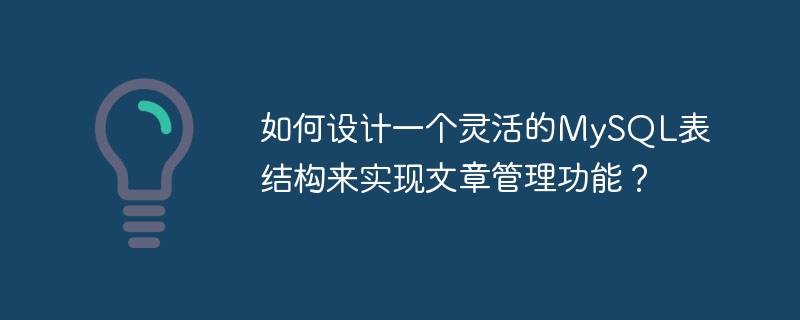

How to design a flexible MySQL table structure to implement article management functions?
When developing an article management system, designing the database table structure is a very important part. A good table structure can improve the performance, maintainability and flexibility of the system. This article will introduce how to design a flexible MySQL table structure to implement article management functions, and provide specific code examples.
The article table is the core table of the article management system, which records all article information. The following is an example article table structure:
CREATE TABLE articles (
id INT(11) NOT NULL AUTO_INCREMENT PRIMARY KEY,
title VARCHAR(255) NOT NULL,
content TEXT NOT NULL,
status ENUM('draft', 'published') NOT NULL DEFAULT 'draft',
created_at TIMESTAMP DEFAULT CURRENT_TIMESTAMP,
updated_at TIMESTAMP DEFAULT CURRENT_TIMESTAMP ON UPDATE CURRENT_TIMESTAMP
);Among them, id is the unique identifier of the article, title is the title of the article, content is the content of the article, status indicates the status of the article (draft or published), created_at and updated_at represent the creation time and last update time of the article respectively.
The authors table records all article author information. The following is an example author table structure:
CREATE TABLE authors (
id INT(11) NOT NULL AUTO_INCREMENT PRIMARY KEY,
name VARCHAR(255) NOT NULL,
email VARCHAR(255) NOT NULL,
created_at TIMESTAMP DEFAULT CURRENT_TIMESTAMP,
updated_at TIMESTAMP DEFAULT CURRENT_TIMESTAMP ON UPDATE CURRENT_TIMESTAMP
);Among them, id is the author's unique identifier, name is the author's name, email is the author's email address, created_at and updated_at represent the author's creation time and last update time respectively. .
The category table is used to classify articles. The following is an example category table structure:
CREATE TABLE categories (
id INT(11) NOT NULL AUTO_INCREMENT PRIMARY KEY,
name VARCHAR(255) NOT NULL,
created_at TIMESTAMP DEFAULT CURRENT_TIMESTAMP,
updated_at TIMESTAMP DEFAULT CURRENT_TIMESTAMP ON UPDATE CURRENT_TIMESTAMP
);Among them, id is the unique identifier of the category, name is the name of the category, created_at and updated_at represent the creation time and last update time of the category respectively.
Since an article can have multiple authors and one author can write multiple articles, an article-author is needed Relationship table to establish a many-to-many relationship between them. The following is an example article-author relationship table structure:
CREATE TABLE article_author (
article_id INT(11) NOT NULL,
author_id INT(11) NOT NULL,
PRIMARY KEY (article_id, author_id),
FOREIGN KEY (article_id) REFERENCES articles(id),
FOREIGN KEY (author_id) REFERENCES authors(id)
);Among them, article_id and author_id are the unique identifiers of the article and author respectively. They are combined as the primary key and also as a foreign key to refer to the corresponding article table. and author table.
Similarly, an article can belong to multiple categories, and a category can contain multiple articles. An article is required - Category relationship tables to establish many-to-many relationships between them. The following is an example article-category relationship table structure:
CREATE TABLE article_category (
article_id INT(11) NOT NULL,
category_id INT(11) NOT NULL,
PRIMARY KEY (article_id, category_id),
FOREIGN KEY (article_id) REFERENCES articles(id),
FOREIGN KEY (category_id) REFERENCES categories(id)
);Among them, article_id and category_id are the unique identifiers of the article and category respectively. When combined, they serve as the primary key and also serve as a foreign key to refer to the corresponding article table. and category table.
Through the above table design, the article management function can be flexibly realized. Developers can further adjust and optimize the table structure according to actual needs. In the code implementation, it is necessary to use the relevant API of MySQL to operate the database and realize the functions of addition, deletion, modification and query. The following is an example PHP code that implements the function of querying all published articles:
<?php
$connection = mysqli_connect("localhost", "username", "password", "database");
$query = "SELECT * FROM articles WHERE status = 'published'";
$result = mysqli_query($connection, $query);
while ($row = mysqli_fetch_assoc($result)) {
echo $row['title'] . "<br>";
echo $row['content'] . "<br>";
echo "<hr>";
}
mysqli_close($connection);
?>Through the above table design and code examples, the article management system can have good performance, maintainability and flexibility , to meet the needs of practical applications. Of course, corresponding adjustments and optimizations need to be made based on specific business scenarios and needs.
The above is the detailed content of How to design a flexible MySQL table structure to implement article management functions?. For more information, please follow other related articles on the PHP Chinese website!




